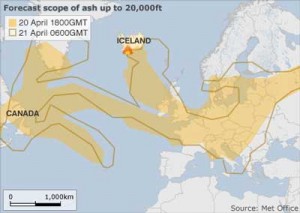 THUNDER BAY – European Organisation for the Safety of Air Navigation reports, “The new procedures agreed yesterday have been in place since 06.00UTC today. At the current time, in the upper airspace above 20,000 feet, all European airspace is available with the exception of Finland which is closed at all levels.
THUNDER BAY – European Organisation for the Safety of Air Navigation reports, “The new procedures agreed yesterday have been in place since 06.00UTC today. At the current time, in the upper airspace above 20,000 feet, all European airspace is available with the exception of Finland which is closed at all levels.
“Almost 75% of the total continent area is free of any restrictions. This area includes: Austria, the Balkan area, Belgium, Bulgaria, Czech Republic, Hungary, Italy, southern France, Greece, the Netherlands, Norway, Poland, Portugal, Spain, Romania, northern Sweden, Switzerland, Turkey, Ukraine.
“Air traffic control services are not being provided to civil aircraft in significant parts of the lower airspace primarily in north-western Europe, including Denmark, Estonia, Ireland, Latvia, Sweden and the UK.
“Air traffic control services are being provided albeit with very significant restrictions on the number of flights authorised, and/or the routes and flight procedures to be followed, in several parts of the lower airspace in north-western Europe, including Germany and northern France”.
There is expected to be a backlog of several days before air travel gets back to normal, and that likely depends on further volcanic activity from Iceland’s Eyjafjallajokull volcano.
The latest reports from the Met Office in Iceland report, “atest available results from GPS stations around Eyjafjallajökull showed deflation associated with the eruption. This suggested that the volume of eruptive material which has been ejected already, relieves pressure off the volcano.
“No movements associated with the Katla volcano are presently observed”.
In terms of predicting future activity, the Met states, “The eruption continues. It is not possible to predict the duration of the eruption. Previous known eruptions from this volcano were in the years 1612, believed to have lasted only three days, and 1821-3, when it erupted on and off for over a year”.

